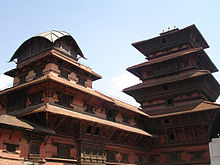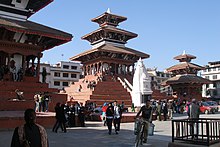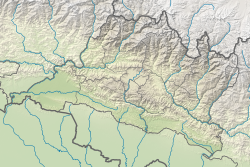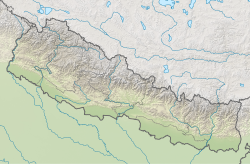|
Kathmandu Valley
 The Kathmandu Valley (Nepali: काठमाडौं उपत्यका), also known as the Nepal Valley or Nepa Valley (Nepali: नेपाः उपत्यका, Nepal Bhasa: 𑐣𑐾𑐥𑐵𑑅 𑐐𑐵𑑅, नेपाः गाः), National Capital Area, is a bowl-shaped valley located in the Himalayan mountains of Nepal. It lies at the crossroads of ancient civilizations of the Indian subcontinent and the broader Asian continent, and has at least 130 important monuments, including several pilgrimage sites for Hindus and Buddhists. The valley holds seven World Heritage Sites within it.[2] The Kathmandu Valley is the most developed and the largest urban agglomeration in Nepal with a population of about 5 million people.[3] The urban agglomeration of Kathmandu Valley includes the cities of Kathmandu, Lalitpur, Bhaktapur, Changunarayan, Budhanilkantha, Tarakeshwar, Gokarneshwar, Suryabinayak, Tokha, Kirtipur, Madhyapur Thimi, and others. The majority of offices and headquarters are located in the valley, making it the economic hub of Nepal. It is popular with tourists for its unique architecture, and rich culture which includes the highest number of jatras (festivals) in Nepal. Kathmandu Valley itself was referred to as "Nepal Proper" by British historians. As per the World Bank, the Kathmandu Valley was one of the fastest growing metropolitan areas in South Asia with 2.5 million population by 2010 and an annual growth rate of 4%.[4] In 2015, Kathmandu Valley was hit by the April 2015 Nepal earthquake.[5] The earthquake caused thousands of deaths and the destruction of many infrastructure across the Kathmandu Valley, which included the towns of Lalitpur, Kirtipur, Madhyapur Thimi, Changunarayan, and Bhaktapur. Kathmandu is also the largest city in the Himalayan hill region. EtymologyHistorically, the valley and adjoining areas made up a confederation known as the Nepal Mandala. Until the 15th century, Bhaktapur was its capital, when two other capitals, Kathmandu and Patan, were established.[6][7][8] Until the 1960s, the Kathmandu Valley was known as the Nepala Valley or Nepa Valley.[9][10] In 1961 the valley was listed as Kathmandu District, which began referring to the valley as Kathmandu Valley.[11] The term Nepa Valley is still used among Newar people[12] and local governments,[13] while senior citizens still tend to refer to the valley as Nepal.[14] The term Swaniga (Nepal Bhasa: 𑐳𑑂𑐰𑐣𑐶𑐐𑑅, स्वनिगः) is used to refer to three cities namely Yén (Kathmandu), Yala (Lalitpur) and Khwapa (Bhaktapur) [15] The Pahari name Kathmandu comes from a structure in the Durbar Square called by the Sanskrit name Kāsṣtha mandapa "Wooden shelter". This unique temple, also known as the Maru Sattal, was built in 1596 by King Lakshmi Narasimha Malla. The entire structure contained no iron nails or supports and was made entirely from wood. Legend has it that the timber used for this two-story pagoda was obtained from a single tree. HistoryThe Kathmandu Valley may have been inhabited as early as 300 BCE, since the oldest known objects in the valley date to a few hundred years BCE. The earliest known inscription is dated 185 CE. The oldest firmly dated building in the earthquake-prone valley is over 2,000 years old. Four stupas around the city of Patan that are said to have been erected by Charumati, a purported daughter of the Maurya emperor Ashoka, in the third century BCE, attest to the ancient history present within the valley. As with the tales of the Buddha's visit, there is no evidence supporting Ashok's visit, but the stupas probably date to that century. The Licchavis, whose earliest inscriptions date to 464, were the next rulers of the valley and had close ties with the Gupta Empire of India. The Mallas ruled the Kathmandu Valley and the surrounding area from the 12th until the 18th century CE, when the Shah dynasty of the Gorkha Kingdom under Prithvi Narayan Shah conquered the valley as he created present-day Nepal. His victory in the Battle of Kirtipur was the beginning of his conquest of the valley.  NewarsThe Newars are the indigenous inhabitants and the creators of the historic civilization of the valley. Their language is today known as Nepal Bhasa.[16] They are understood to be the descendants of the various ethnic and racial groups that have inhabited and ruled the valley in the two-millennium history of the place. Scholars have also described the Newars as a nation.[17] They have developed a division of labour and a sophisticated urban civilization not seen elsewhere in the Himalayan foothills. They are known for their contributions to art, sculpture, architecture, culture, literature, music, industry, trade, agriculture and cuisine, and have left their mark on the art of Central Asia. Newa architecture consists of the pagoda, stupa, shikhara, chaitya and other styles. [18] The valley's trademark is the multiple-roofed pagoda which may have originated in this area and spread to India, China, Indochina and Japan.[19][20] The most famous artisan who influenced stylistic developments in China and Tibet was Araniko, a Newar who traveled to the court of Kublai Khan in the 13th century AD.[19] He is known for building the white stupa at the Miaoying Temple in Beijing. At present, people from other parts of Nepal tend to migrate to the valley for a better life due to its high level of cultural and economic development. Even with urbanization taking place, the Newars have sustained their culture in the Kathmandu Valley. Mythology According to Swayambhu Puran, the Kathmandu Valley was once a lake, deemed by scientists as Paleo Kathmandu Lake.[21] The hill where the Swayambu Stupa rests had lotus plants with flowers in bloom. One story says that the God Manjusri cut a gorge at a valley called Kashapaal (later called Chobhar) with a sword called Chandrahrasha and drained away the waters in order to establish a habitable land. According to Gopal Banshawali, Krishna cut the gorge with his Sudarshana Chakra to let the water out. He then handed the drained valley to the Gopal Vansi people, who were nomadic cow herders. Geography Kathmandu valley is bowl-shaped. Its central lower part stands at 1,425 m (4,675 ft). Kathmandu valley is surrounded by five mountain ranges: Shivapuri hills (at an elevation of 2,732 m (8,963 ft)), Phulchowki (2,762 metres or 9,062 feet), Nagarjun (2,128 metres or 6,982 feet), Champadevi (2,278 m (7,474 ft)) and Chandragiri (2,551 m (8,369 ft)). The major river flowing through the Kathmandu Valley is the Bagmati River. The valley is made up of the Kathmandu District, Lalitpur District and Bhaktapur District covering an area of 220 square miles (570 km2). The valley consists of the municipal areas of Kathmandu, Patan, Bhaktapur, Kirtipur and Madhyapur Thimi; the remaining area is made up of a number of municipalities and rural municipalities in Lalitpur district. The valley is a cultural and political hub of Nepal. The Kathmandu Valley was accorded the status of a World Heritage Site by UNESCO in the year 1979.[22] Notable areas  This is an incomplete alphabetical list of notable temples and monuments in Kathmandu Valley. Seven of these are designated as UNESCO World Heritage Sites.[2]
Present This valley hosts a UNESCO World Heritage Site with seven preserved locations: the centers of the three primary cities, Kathmandu Hanuman Dhoka, Patan Durbar Square and Bhaktapur Durbar Square, the two most important Buddhist stupas, Swayambhunath and Boudhanath and two famous Hindu shrines, Pashupatinath temple and Changu Narayan.[23] In 2003, UNESCO listed the sites as being "endangered" out of concern for the ongoing loss of authenticity and the outstanding universal value of the cultural property. The endangered status was lifted in 2007.[24] In the past, Tibetan Buddhist Masters including Marpa, Milarepa, Rwa Lotsava, Ras Chungpa, Dharma Swami, XIII Karmapa, XVI Karmapa and several others visited and travelled in the Kathmandu Valley. However, the largest group of Tibetans came in the 1960s. Many settled around the Swayambhunath and Boudhanath Stupas. Many other famous Lamas known throughout the world have their Buddhist monasteries and centers in the Kathmandu Valley.[25] The 1500-year history of funerary architecture in the valley provides some of the finest examples of stone architecture found in the subcontinent. A caitya is placed in almost all courtyards in cities like Patan.[26] Stone inscriptions in the Kathmandu Valley are important sources for the history of Nepal. DemographicsKathmandu Valley has total population of 2,996,341.[27] Kathmandu (National Capital Area)
In 2015, the Government of Nepal proposed to develop Kathmandu valley as a separate national capital territory and not a part of Bagmati Province.[28][29][30] Kathmandu Valley consists 3 Districts of Bagmati Province whose total population is 2,996,341 and total area is 933.73 km2 (360.52 sq mi)
Major citiesCities and towns with 75,000+ population of Kathmandu Valley as per 2021 Nepal census.[3]
See alsoReferences
External linksWikimedia Commons has media related to Kathmandu Valley. Wikivoyage has a travel guide for Kathmandu Valley.
|
||||||||||||||||||||||||||||||||||||||||||||||||||||||||||||||||||||||||||||||||||||||||||||||||||||||||||||||||||||||||||||||||||||||||||||||||||||||||||







